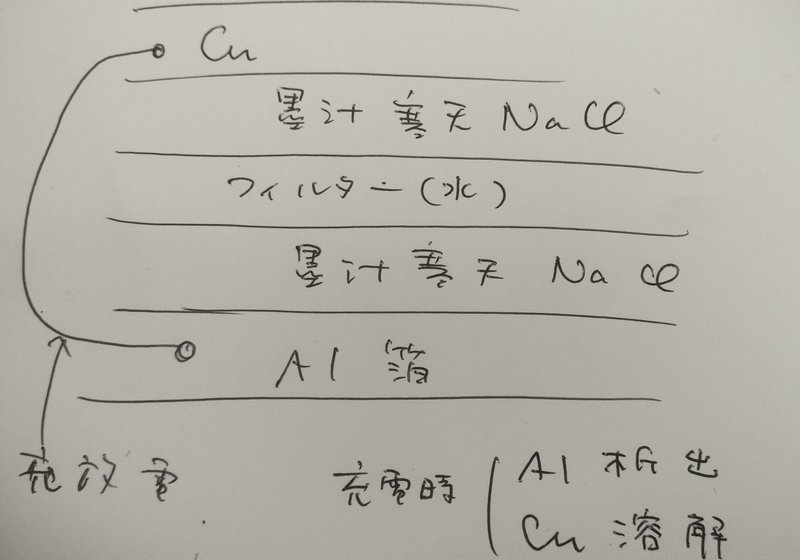
スーパーキャパシタDIYプロジェクト 墨汁寒天と銅板とアルミニウム電極
スーパーキャパシタDIYプロジェクトについて、墨汁と寒天を使ってキャパシタを作る方法を紹介します。
塩水入りの寒天に墨汁を垂らし、ティッシュやコーヒーフィルターで挟み込んだキャパシタは、活性炭を使わずに充放電が可能です。
充電は1.2ボルト、600ミリアンペア、放電は0.9ボルト、120ミリアンペアとなっており、墨汁の炭成分は200ミリグラム以下となっています。
また、キャパシタの絶縁体としては、乾燥したままに保つのが難しいため、通常の水を塗ったフィルターを使用することが望ましいです。
さらに、キャパシタとしてだけでなく、電池としても機能する可能性もあります。このDIYプロジェクトでは、アルミ箔を下部平面電極として使用し、上に活性炭とステンレスを積み上げた構造になっています。そして、アルミイオンが閉じ込められることでキャパシタが形成され、充放電が可能となります。
最後に、上部電極を銅板電極に変更した結果、充電時の電流が小さくなり、充電時に銅が溶けて放電時に析出する仕組みとなりました。
【墨汁と寒天】
塩水入り寒天に墨汁を垂らしたモノ2枚で、ティッシュやコーヒーフィルターを挟み込んだキャパシタを作ってみた。下部集電体電極はアルミニウム箔、上部集電体電極はステンレスメッシュだ。
活性炭でなくても墨汁寒天で充放電できるキャパシタは出来た。
充放電特性は
充電は1.2ボルト、600ミリアンペア
放電は0.9ボルト、120ミリアンペア
だ。
【活性炭の重さで比べる】活性炭1グラム当たりという揃え方ならば、墨汁は1ミリリットルで、1グラムの墨汁の内の炭成分は200ミリグラム以下だと思う。
1グラム当たり150ファラドが標準なら200ミリグラムで30ファラドぐらいが目安だ。
【静電容量】DIYキャパシタの静電容量は測れていない。
30ファラド放電できるなら、0.12アンペア放電なら230秒放電。
30ファラドをフル充電するなら60秒かかる。
【真水 絶縁フィルター】
電極間に挟むフィルターは絶縁体が望ましい。塩水と墨汁がフィルターに染み込むと充電時に電圧がかからない。つまりキャパシタとして機能しない。
乾燥したままに保つのは難しいので普通の水で塗らしたフィルターを使うと絶縁体として働きキャパシタとして充放電できる。
【水フィルターの電解質としての役割】
アルミニウムと接する寒天との間にアルミニウムイオンが溶ける。上部ステンレス電極は塩水寒天と電子のやりとりができる。中間真水フィルターは絶縁体のままでも、キャパシタだけでなく電池として働く分も少しは、あると思う。
●自己充電キャパシタ
アルミニウム空気バッテリーの最初の放電はキャパシタに蓄積されます。バッテリーの最初の放電がキャパシタに蓄えられる様子を自己充電キャパシタと名付けました。
●アルミ箔活性炭電池の構成
アルミ活性炭電池は、充電を想定していない。このDIYプロジェクトでは、アルミ箔を下部平面電極として使用し、集電体としても電極としても機能する。上に活性炭とステンレスを積み上げたような構造になっている。
●アルミ活性炭電池の充電の仕組み
電解液に溶けたアルミ箔が完全にボロボロになる前に充電すれば、充電が可能。電解液に溶けたアルミイオンは、アルミ箔、フィルター、活性炭の間に閉じ込められ、キャパシタとなり、二次電池と同様の電池を形成する。
●銅製の上部電極
上部電極をステンレスから銅板電極に変更。充放電特性は、
充電1.9ボルト・250mA、
放電1.4ボルト・170mA。
ステンレスメッシュ電極から接触面積が増えた。充電時の電流は小さい。絶縁コンデンサーとして機能する。放電電圧と電流はともに増加している。充電時に銅が溶け、放電時に析出したものと思われる。銅は鉄よりも貴金属なので、電圧が上昇したのは理解できる。
●This is a simple activated carbon battery, but it will be a battery with the aluminum foil side as the negative electrode. It also seems to have the property as a capacitor that can be charged and discharged with the aluminum side as the negative pole.
●Carbon ink and agar
I made a capacitor by sandwiching a tissue or coffee filter between two pieces of agar containing salt water and ink. The lower current collector electrode is made of aluminum foil and the upper current collector electrode is made of stainless steel mesh.
●Even without activated charcoal, the ink agar was enough to make a capacitor that can charge and discharge.
Charge and discharge characteristics are
Charging: 1.2 volts, 600 mA
Discharge: 0.9 volts, 120 mA
The charge/discharge characteristic is 0.9 volts, 120 mA.
If we use a per gram of activated charcoal, then 1 milliliter of ink is 1 gram of charcoal, and 1 gram of ink contains less than 200 milligrams of charcoal.
If 150 farads per gram is the standard, then 200 milligrams would be about 30 farads.
●Capacitance has not been measured.
If you can discharge 30 farads, a 0.12 amp discharge would discharge for 230 seconds.
A full charge of 30 farads would take 60 seconds.
●Fresh water Insulating filter
The filter between the electrodes should be an insulator. If salt water and India ink soak into the filter, no voltage will be applied when charging. In other words, it will not function as a capacitor.
It is difficult to keep the filter dry, so a filter coated with plain water acts as an insulator and can be charged and discharged as a capacitor.
●Water filter
Aluminum ions dissolve between the aluminum and the agar in contact with the aluminum. The upper stainless steel electrode can exchange electrons with the salt water agar. Even if the middle fresh water filter remains as an insulator, it can work as a battery as well as a capacitor.
●Self-charging capacitor
The first discharge of the battery is stored in the capacitor. The first discharge of the battery is stored in the capacitor.
●Aluminum foil activated carbon battery charging
Aluminum foil activated carbon batteries are not supposed to be charged or discharged. In this DIY project, aluminum foil is used as the lower flat electrode, which also serves as a current collector. The structure is a stack of activated carbon and stainless steel, as if piled up.
●How the aluminum activated carbon battery is charged.
The battery can be charged and discharged when it is recharged before the aluminum foil that dissolves in the electrolyte is completely torn apart. The aluminum ions that dissolve in the electrolyte are trapped between the aluminum foil, filter, and activated carbon to form a capacitor and a battery similar to a secondary battery.
●Copper top electrode
The top electrode was changed from stainless steel to a copper plate electrode. Charge and discharge characteristics are 1.9 volts and 250 mA for charge and 1.4 volts and 170 mA for discharge. The area in contact is increased from the stainless steel mesh electrode. The current during charging is low. It functions as an insulated capacitor.
Both the discharge voltage and current have increased. It is likely that copper melts during charging and precipitates during discharge. Copper is a more noble metal than iron, so it is understandable that the voltage has increased.

この記事が気に入ったらサポートをしてみませんか?
